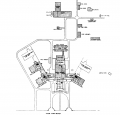Difference between revisions of "Lake County Poor Asylum"
(Created page with "{{infobox institution | name = Lake County Poor Asylum | image = INlake.png | image_size = 250px | alt = | caption = | established = 1884 | construction_began = 1912 | construc...") |
m |
||
| Line 17: | Line 17: | ||
| architecture_style = | | architecture_style = | ||
| peak_patient_population = | | peak_patient_population = | ||
| − | | alternate_names = | + | | alternate_names =<br> |
| − | + | *Lake County Sanitarium | |
}} | }} | ||
Revision as of 05:04, 15 November 2015
| Lake County Poor Asylum | |
|---|---|
 | |
| Established | 1884 |
| Construction Began | 1912 |
| Opened | 1913 |
| Current Status | Preserved |
| Building Style | Single Building |
| Architect(s) | M. Beers |
| Location | Crown Point, IN |
| Alternate Names |
|
History
The original location was 4 miles from Crown Point and known as the "County Farm". By the turn of the century a new facility was need as Lake County was growing rapidly due to the new steel mills in Gary. The new buildings consisted of an administration building, 2 men's dormitories, 1 women's dormitory, kitchen & a cell house. The facility was set-up to be self sufficient and the power plant could handle a capacity of about 500. The building's wings were laid out in a way that future expansion would be easily completed. The total cost at the time for the buildings, fully furnished, was about $180,000. The administration building was connected to the dormitories by large enclosed porches that could allow fresh air & sunlight. The dormitory wings are placed at an angle with the central group of buildings for sunlight and air & to facilitate courtyards for outdoor recreation.
The building became a short-term mental health facility after WW2. Patients were either released from here after treatment or relocated to Logansport or Westville State Hospital for long-term treatment. In the 1960s some of the original wings were demolished and a new multi-story building was constructed as a nursing home. By the 1970s the original asylum was converted to be used as offices and still is today.

